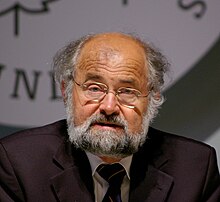Erwin Neher
Erwin Neher (born March 20, 1944 in Landsberg am Lech , Bavaria ) is a German biophysicist .
Erwin Neher and Bert Sakmann received the Nobel Prize in Physiology or Medicine in 1991 for their development of a method for the direct detection of individual ion channels in cell membranes. Both scientists played a leading role in the development of the patch clamp technique , which formed the basis for their discoveries.
Erwin Neher has been director at the Max Planck Institute for Biophysical Chemistry in Göttingen and head of the membrane biophysics department since 1983 .
Life
Neher is the son of Franz Xaver Neher, employee of a dairy products company, and Elisabeth Neher (née Pfeiffer), a trained teacher. He has two older sisters. Erwin Neher attended the high school of the Marist school brothers in Mindelheim . Mathematics and physics were his favorite subjects there. He spent his youth in Buchloe . In his spare time he was interested in the newly published literature on cybernetics . From 1963 he studied physics at the Technical University of Munich and from 1966 with the help of a Fulbright scholarship at the University of Wisconsin .
At the Max Planck Institute for Psychiatry in Munich he received his doctorate in 1970 under Hans Dieter Lux , in whose laboratory he also met Bert Sakmann. From 1976 Neher and Sakmann had a Young Investigator Laboratory at the University of Göttingen , where they worked together with other researchers.
Neher has been married to Eva-Maria Neher since 1978 , with whom he has five children.
Awards and honors
In addition to the Nobel Prize, he received numerous other awards, including an honorary professorship in Göttingen and ten honorary doctorates on four different continents, as well as the W. Alden Spencer Award in 1983 , the Adolf Fick Prize in 1984 , the Louisa Gross Horwitz Prize in 1986 , 1987 the Gottfried Wilhelm Leibniz Prize of the German Research Foundation , a Gairdner Foundation International Award in 1989 , the Ralph W. Gerard Prize in 1991 and the Lower Saxony State Prize for Science in 1990 . In 1989 he was elected to the Academia Europaea and the National Academy of Sciences and in 1992 to the American Academy of Arts and Sciences , since 1992 he has been a full member of the Academy of Sciences in Göttingen , since 1998 a member of the German Academy of Sciences Leopoldina , since 2008 National Academy of Sciences. In 1994 he was admitted to the Royal Society as a foreign member . Erwin Neher is also an honorary citizen of his hometown Buchloe. In 2004 he also received the Karl-Küpfmüller-Ring from the Technical University of Darmstadt.
literature
- Gisela Baumgart: Neher, Erwin. In: Werner E. Gerabek , Bernhard D. Haage, Gundolf Keil , Wolfgang Wegner (eds.): Enzyklopädie Medizingeschichte. De Gruyter, Berlin / New York 2005, ISBN 3-11-015714-4 , p. 1029.
- Erwin Neher: Ion channels for inter- and intracellular communication. In: Angewandte Chemie. Volume 104, 1992, pp. 837-843 (Nobel Prize Lecture).
- Erwin Neher, Bert Sakmann: Research into cell signals with the patch-clamp technique. In: Spectrum of Science. Volume 5, 1992, pp. 48-56.
Web links
- Literature by and about Erwin Neher in the catalog of the German National Library
- Autobiography for the Nobel Committee
- Information from the Nobel Foundation on the 1991 award to Erwin Neher (English) and Nobel publication (English; PDF; 419 kB)
Individual evidence
- ↑ Directory of members: Erwin Neher. Academia Europaea, accessed on July 9, 2017 .
- ^ Member Directory: Erwin Neher. National Academy of Sciences, accessed July 9, 2017 .
- ↑ Prof. Dr. Erwin Neher , website of the Göttingen Academy of Sciences, accessed on March 1, 2019.
- ↑ Member entry by Prof. Dr. Erwin Neher (with picture and CV) at the German Academy of Natural Scientists Leopoldina , accessed on July 15, 2016.
- ^ Fellows Directory: Erwin Neher. Royal Society, accessed July 9, 2017 .
- ↑ Brief portrait of the city , Buchloe website, accessed on December 19, 2015.
- ↑ https://www.sim.informatik.tu-darmstadt.de/presse/files/tud-intern-2004-04.pdf
| personal data | |
|---|---|
| SURNAME | Neher, Erwin |
| BRIEF DESCRIPTION | German physician and Nobel Prize winner |
| DATE OF BIRTH | March 20, 1944 |
| PLACE OF BIRTH | Landsberg am Lech , Bavaria |
